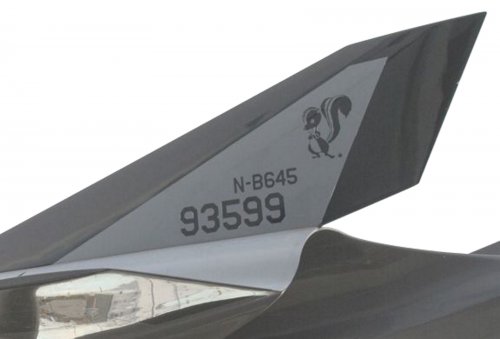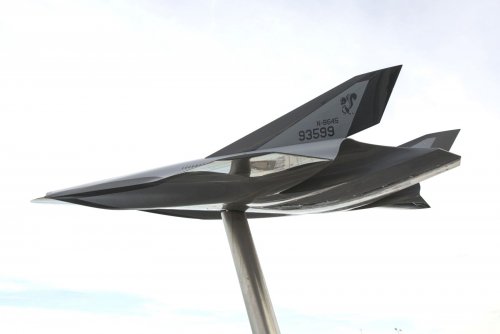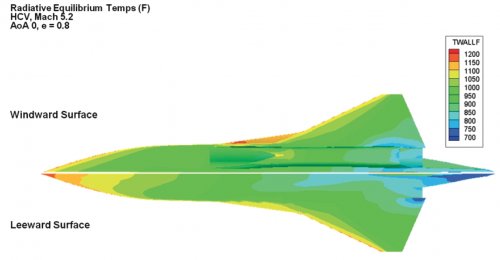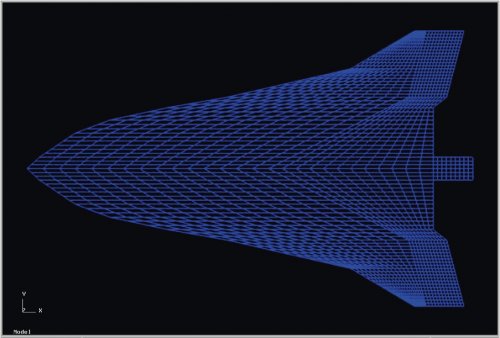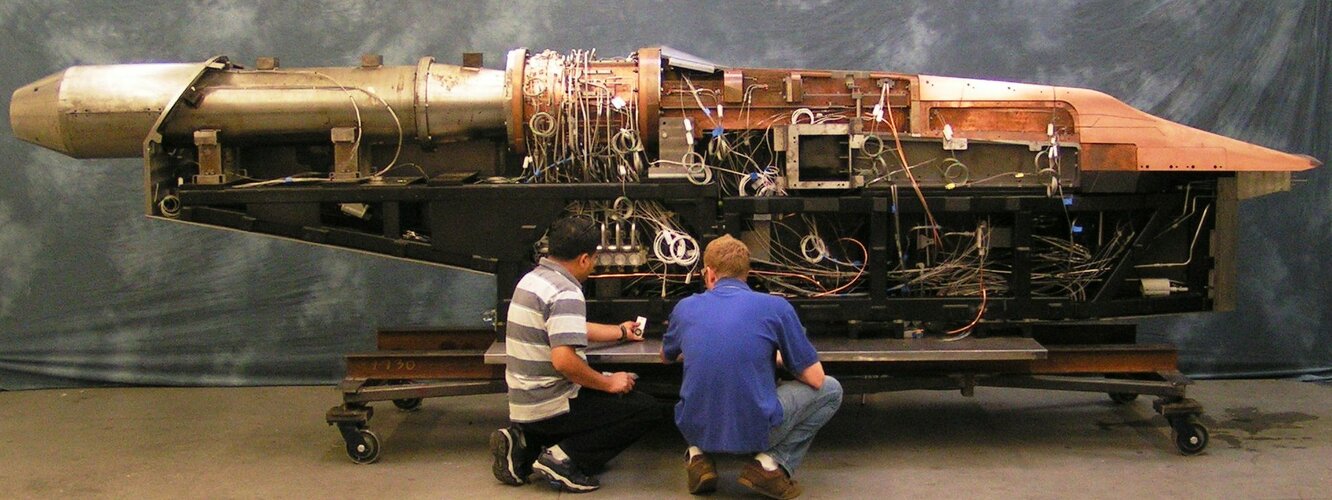You are using an out of date browser. It may not display this or other websites correctly.
You should upgrade or use an alternative browser.
You should upgrade or use an alternative browser.
DARPA/LM Skunk Works Blackswift (HTV-3X)
- Thread starter fightingirish
- Start date
It's Chritmas time : a little more money for some direct connect test. Probably to power Santa Claus sleigh  ?
?
https://www.fbo.gov/index?s=opportunity&mode=form&id=5bb1e5634566b55e7ee94effeb1253f0&tab=core&_cview=0
TURBINE-BASED COMBINED-CYCLE LOW MACH RISK REDUCTION DIRECT CONNECT COMBUSTOR TESTING
Solicitation Number: NNC15TA07T
Agency: National Aeronautics and Space Administration Office: Glenn Research Center
Contract Award Date:
December 15, 2014
Contract Award Dollar Amount: 1099916
Contractor Awardee: Aerojet Rocketdyne HWY 50 & Aerojet Rd Rancho Cordova, CA 95670-6000
More here :SCOPE OF WORK
The overall objective of the proposed Turbine-Based Combined-Cycle (TBCC) Low Mach Risk Reduction Direct Connect Combustor (DCC) Testing is to advance key enabling technology for TBCC hypersonic propulsion systems by extending low Mach and altitude operation of AR’s 3rd generation powerhead for the dual-mode scramjet propulsion system while maintaining maximum flight Mach capability. The specific objectives are to explore and characterize ignition, operability and performance at simulated conditions representing Combined Cycle and Ramjet modes of operation over the mode transition corridor. AR will conduct a hydrocarbon fueled direct connect test that provides a flexible, low cost approach which will reduce risk for TBCC hypersonic propulsion systems. The contractor shall perform the following Tasks: (1) task planning and status, (2) integrated and coordinated pre-test analyses, (3) hardware refurbishment and fabrication, (4) ground tests in a jet burner test stand, and (5) post-test data analysis and reporting to meet program objectives.
https://www.fbo.gov/index?s=opportunity&mode=form&id=5bb1e5634566b55e7ee94effeb1253f0&tab=core&_cview=0
liaomh
I really should change my personal text
- Joined
- 25 February 2015
- Messages
- 25
- Reaction score
- 3
The U.S. Air Force is launching a new air-supremacy effort designed to identify and develop next-generation technologies to maintain America's air dominance through 2030 at the same time the future of stealth is being questioned.
The service has stood up teams to experiment and conduct technology demonstrations to identify innovations that will guide the service and its platforms into future in which the Air Force expects to face more threats from advanced militaries like China or North Korea, Lt. Gen. Ellen Pawlikowski, military deputy for Air Force acquisition, told Military.com.
When it comes to hypersonic flight, Pawlikowski emphasized that the service will not only explore hypersonic weapons but also hypersonic aircraft designed to carry and deliver the weapons.
http://www.military.com/daily-news/2015/02/20/air-force-launches-new-air-supremacy-effort-for-2030.html
The service has stood up teams to experiment and conduct technology demonstrations to identify innovations that will guide the service and its platforms into future in which the Air Force expects to face more threats from advanced militaries like China or North Korea, Lt. Gen. Ellen Pawlikowski, military deputy for Air Force acquisition, told Military.com.
When it comes to hypersonic flight, Pawlikowski emphasized that the service will not only explore hypersonic weapons but also hypersonic aircraft designed to carry and deliver the weapons.
http://www.military.com/daily-news/2015/02/20/air-force-launches-new-air-supremacy-effort-for-2030.html
liaomh
I really should change my personal text
- Joined
- 25 February 2015
- Messages
- 25
- Reaction score
- 3
Beyond the Hyper
—John A. Tirpak1/22/2015
The Air Force and the Defense Advanced Research Projects Agency hope to start flying follow-ons to the X-51 hypersonic testbed circa 2018, Maj. Gen. Thomas Masiello, head of Air Force Research Laboratory, told Air Force Magazine in a Wednesday interview. "We've each invested about $300 million" in a project AFRL is calling the High Speed Strike Weapon, Masiello said. Two hypersonic vehicles are being explored: one is a waverider using technology like that of the X-51, which achieved 209 seconds of hypersonic flying in 2013. The other is called tactical boost-glide technology, "where there's no scramjet power; you're just basically taking a booster, accelerating it to hypersonic speed, then it glides to the target," Masiello explained. If all goes well, he said, by 2020, "we could have the technology matured to the point of a program of record," applying hypersonics to a cruise missile-type of weapon "with an acceptable level of risk." Beyond that, by 2030, Masiello envisions a reusable platform that could be used for intelligence, surveillance, and reconnaissance work, which could be turned within days between missions. By "2040-plus" AFRL expects "a no-kidding, re-usable, persistent, penetrating hypersonic vehicle that could be manned or unmanned."
this time, he said "by 2030",not "2030s".
—John A. Tirpak1/22/2015
The Air Force and the Defense Advanced Research Projects Agency hope to start flying follow-ons to the X-51 hypersonic testbed circa 2018, Maj. Gen. Thomas Masiello, head of Air Force Research Laboratory, told Air Force Magazine in a Wednesday interview. "We've each invested about $300 million" in a project AFRL is calling the High Speed Strike Weapon, Masiello said. Two hypersonic vehicles are being explored: one is a waverider using technology like that of the X-51, which achieved 209 seconds of hypersonic flying in 2013. The other is called tactical boost-glide technology, "where there's no scramjet power; you're just basically taking a booster, accelerating it to hypersonic speed, then it glides to the target," Masiello explained. If all goes well, he said, by 2020, "we could have the technology matured to the point of a program of record," applying hypersonics to a cruise missile-type of weapon "with an acceptable level of risk." Beyond that, by 2030, Masiello envisions a reusable platform that could be used for intelligence, surveillance, and reconnaissance work, which could be turned within days between missions. By "2040-plus" AFRL expects "a no-kidding, re-usable, persistent, penetrating hypersonic vehicle that could be manned or unmanned."
this time, he said "by 2030",not "2030s".
kagemusha
ACCESS: Restricted
- Joined
- 1 February 2010
- Messages
- 48
- Reaction score
- 15
liaomh said:this time, he said "by 2030",not "2030s".
2030+
Attachments
- Joined
- 21 April 2009
- Messages
- 13,756
- Reaction score
- 7,696
sferrin said:If they didn't quit every time things got a little less than 100% certain maybe. As it is, maybe by 2300.
And as I have posted in the Prompt Global Strike thread a USAF general said "we could have very fast missiles now" which I assumed were good old fashioned solid rocket propulsion or maybe an ASALM type system to which I asked "Yes why not built something like that NOW and keep researching air-breathing options for later"
- Joined
- 21 April 2009
- Messages
- 13,756
- Reaction score
- 7,696
DSE said:bobbymike said:And as I have posted in the Prompt Global Strike thread a USAF general said "we could have very fast missiles now" which I assumed were good old fashioned solid rocket propulsion or maybe an ASALM type system to which I asked "Yes why not built something like that NOW and keep researching air-breathing options for later"
Show me the money! In the scheme of the DoD and OSD overall budgets the $$ allocated here are peanuts. As to the 2030 statement, these programs are just in the infancy of the S&T phase. When and if T&E begins in earnest then folks are starting to get serious. The players involved can't even agree on how the T&E "might" be done at this point.
Well there was a recent FBO for an air launched boost glide system for the USAF
- Joined
- 21 April 2009
- Messages
- 13,756
- Reaction score
- 7,696
DSE said:bobbymike said:Well there was a recent FBO for an air launched boost glide system for the USAF
Again, isn't this still in the S&T realm? Mach 10ish ala AWH or Mach 20+ish ala HTV-2? For the latter we really don't even have the full suite of S&T facilities let alone T&E, do we?
The Tactical Boost Glide (TBG) program is a DARPA / Air Force effort that will
develop and demonstrate technologies to enable air-launched tactical range
hypersonic boost glide systems, including a flight demonstration. The program
will also consider traceability to, and ideally compatibility with, sea-launch
platforms. The program will address the system and technology issues required to
enable development of a hypersonic boost glide system considering (1) vehicle
concepts possessing the required aerodynamic and aerothermal performance,
controllability and robustness for a wide operational envelope, (2) the system
attributes and subsystems required to be effective in relevant operational
environments, and (3) approaches to reducing cost and improving affordability for
both the demonstration system and future operational systems
Yes early day it seems but reading between the lines it seems like an ATACMS booster "type" system but with a glider/warhead front end rather than the X-51 up there. To me when I watched the X-51 launch I thought why not just put a warhead on the front end of the booster and have a conventional SRAM (kind of) missile. ATACMS can get you M4+ and a real deliverable weapon sooner it seems.
Totally IMHO but I keyed on the word tactical range system but to be honest what does that mean, 500km, 1000km?
No indeed, however there is now a RFI about the T&E facilities that might be needed (posted in the CPGS thread) :DSE said:bobbymike said:Well there was a recent FBO for an air launched boost glide system for the USAF
Again, isn't this still in the S&T realm? Mach 10ish ala AWH or Mach 20+ish ala HTV-2? For the latter we really don't even have the full suite of S&T facilities let alone T&E, do we?
HSS Study [...]
The DoD Test Resource Management Center (TRMC) is seeking to improve the ground and flight test capabilities needed to effectively and efficiently mature, develop, and test high-speed / hypersonic (Mach 5+) systems. Ground- and air-based test and evaluation (T&E) capabilities for both air-breathing and non-air-breathing systems, subsystems, and technologies are of interest; in particular, those associated with scramjet-powered cruise missile system, tactical boost-glide system, and strategic boost-glide system development.
The same thing with a Pegasus instead of ATACMS might be fun.bobbymike said:Yes early day it seems but reading between the lines it seems like an ATACMS booster "type" system but with a glider/warhead front end rather than the X-51 up there. To me when I watched the X-51 launch I thought why not just put a warhead on the front end of the booster and have a conventional SRAM (kind of) missile. ATACMS can get you M4+ and a real deliverable weapon sooner it seems.
liaomh
I really should change my personal text
- Joined
- 25 February 2015
- Messages
- 25
- Reaction score
- 3
kagemusha said:liaomh said:this time, he said "by 2030",not "2030s".
2030+
very thanks for your pic, i find this pdf.
liaomh
I really should change my personal text
- Joined
- 25 February 2015
- Messages
- 25
- Reaction score
- 3
INSIDE AMERICA'S NEXT SPYPLANE
A SECRET, HYPERSONIC REPLACEMENT FOR THE LEGENDARY SR-71 PROMISES TO TRANSFORM MILITARY AVIATION
By Clay Dillow Posted May 19, 2015
226

The SR-72 will travel at six times the speed of sound—the fastest military jet ever made—and fly as high as 80,000 feet.
Born in the spy-vs.-spy cauldron of the Cold War, the iconic SR-71 “Blackbird” remains the fastest air-breathing military aircraft the world has known. It flew so high and so fast that enemy defenses were powerless to intercept it. Eventually, satellite technology and advanced radar eroded its advantage. In 1998, the U.S. Air Force retired it. Now, with regional threats growing and portable surface-to-air missiles evolving, engineers have once again set out to build the fastest military jet on the planet.
This time, it will take the form of a 4,000-mile-per-hour reconnaissance drone with strike capability. Known as the SR-72, the aircraft will evade assault, take spy photos, and attack targets at speeds of up to Mach 6. That’s twice as fast as its predecessor.
Aeronautical engineers at Lockheed Martin and Aerojet Rocketdyne have been designing the SR-72 at their Skunk Works black site in California for the past several years. It will require a hybrid propulsion system: a conventional, off-the-shelf turbo jet that can take the plane from runway to Mach 3, and a hypersonic ramjet/scramjet that will push it the rest of the way. Its body will have to withstand the extreme heat of hypersonic flight, when air friction alone could melt steel. Its bombs will have to hit targets from possibly 80,000 feet. Lockheed says the craft could be deployed by 2030. Once it is, the plane’s ability to cover one mile per second means it could reach any location on any continent in an hour—not that you’ll see it coming.
"We are now on the verge of a hypersonic revolution."
—Brad Leland, Lockheed Martin's Hypersonic Program Manager
HOW RAMJETS WORK
Ramjets forgo the big rotary compressors needed on turbojets and instead rely on their own forward motion to compress air. First, air is scooped into an inlet and compressed as it funnels into a diffuser. The diffuser also slows the air to subsonic speeds for easier combustion. From there, air and fuel are fed into a combustion chamber and ignited. Finally, an exhaust nozzle accelerates the resulting burst of hot, expanding air, producing massive thrust.
PROPULSION
Turbojet engines can take a plane from runway launch to about Mach 3; speeds faster than that require an air-breathing ramjet, which compresses high-speed air for combustion, but which typically begins operating at about Mach 4. To bridge the gap, engineers are developing a hybrid engine that can operate in three modes. The aircraft will accelerate to about Mach 3 under turbojet power, switch to ramjet power to take it to about Mach 5, and then switch again to scramjet mode, which uses supersonic air for combustion.
It could reach any location on any continent in an hour—not that you’ll see it coming.
SKIN
Aerodynamic friction at speeds exceeding Mach 5 will heat an aircraft’s exterior to 2,000 degrees. At that point, conventional steel airframes will melt. So engineers are looking at composites—the same kinds of high-performance carbon, ceramic, and metal mixes used for the noses of intercontinental ballistic missiles and space shuttles. Every joint and seam must be sealed: Any air leak at hypersonic speed, and the in-rushing heat would cause the aircraft to collapse. (That’s what doomed the space shuttle Columbia).
AIRFRAME
The stresses on a plane shift as it travels through subsonic, supersonic, and hypersonic speeds. For instance, when a jet is accelerating through subsonic flight, the center of lift moves toward the back of the aircraft. But once the craft hits hypersonic speeds, drag on the plane’s leading egdes cause the center of lift to move forward again. If the ceter of lift gets too close to the center of gravity it can cause dangerous instability. The plane’s shape must tolerate these changes, and more, to keep the craft from tearing apart.
PAYLOAD
Lockheed describes the SR-72 as an intelligence, surveillance, reconnaissance, and strike platform, but its exact payload is secret. Most likely, it hasn’t yet been invented. Taking spy photos or dropping bombs at Mach 6 will require extraordinary engineering. It will require hundreds of miles to make a turn. It will need powerful guidance computers to line up targets, 80,000 feet below. Also, you can’t just open a bomb bay at 4,000 miles per hour. The SR-72 will need new sensors and weapons to operate at such high speeds.
This article was originally published in the June 2015 issue of Popular Science, under the title "America's Next Spyplane.”
http://www.popsci.com/inside-americas-next-spyplane
A SECRET, HYPERSONIC REPLACEMENT FOR THE LEGENDARY SR-71 PROMISES TO TRANSFORM MILITARY AVIATION
By Clay Dillow Posted May 19, 2015
226

The SR-72 will travel at six times the speed of sound—the fastest military jet ever made—and fly as high as 80,000 feet.
Born in the spy-vs.-spy cauldron of the Cold War, the iconic SR-71 “Blackbird” remains the fastest air-breathing military aircraft the world has known. It flew so high and so fast that enemy defenses were powerless to intercept it. Eventually, satellite technology and advanced radar eroded its advantage. In 1998, the U.S. Air Force retired it. Now, with regional threats growing and portable surface-to-air missiles evolving, engineers have once again set out to build the fastest military jet on the planet.
This time, it will take the form of a 4,000-mile-per-hour reconnaissance drone with strike capability. Known as the SR-72, the aircraft will evade assault, take spy photos, and attack targets at speeds of up to Mach 6. That’s twice as fast as its predecessor.
Aeronautical engineers at Lockheed Martin and Aerojet Rocketdyne have been designing the SR-72 at their Skunk Works black site in California for the past several years. It will require a hybrid propulsion system: a conventional, off-the-shelf turbo jet that can take the plane from runway to Mach 3, and a hypersonic ramjet/scramjet that will push it the rest of the way. Its body will have to withstand the extreme heat of hypersonic flight, when air friction alone could melt steel. Its bombs will have to hit targets from possibly 80,000 feet. Lockheed says the craft could be deployed by 2030. Once it is, the plane’s ability to cover one mile per second means it could reach any location on any continent in an hour—not that you’ll see it coming.
"We are now on the verge of a hypersonic revolution."
—Brad Leland, Lockheed Martin's Hypersonic Program Manager
HOW RAMJETS WORK
Ramjets forgo the big rotary compressors needed on turbojets and instead rely on their own forward motion to compress air. First, air is scooped into an inlet and compressed as it funnels into a diffuser. The diffuser also slows the air to subsonic speeds for easier combustion. From there, air and fuel are fed into a combustion chamber and ignited. Finally, an exhaust nozzle accelerates the resulting burst of hot, expanding air, producing massive thrust.
PROPULSION
Turbojet engines can take a plane from runway launch to about Mach 3; speeds faster than that require an air-breathing ramjet, which compresses high-speed air for combustion, but which typically begins operating at about Mach 4. To bridge the gap, engineers are developing a hybrid engine that can operate in three modes. The aircraft will accelerate to about Mach 3 under turbojet power, switch to ramjet power to take it to about Mach 5, and then switch again to scramjet mode, which uses supersonic air for combustion.
It could reach any location on any continent in an hour—not that you’ll see it coming.
SKIN
Aerodynamic friction at speeds exceeding Mach 5 will heat an aircraft’s exterior to 2,000 degrees. At that point, conventional steel airframes will melt. So engineers are looking at composites—the same kinds of high-performance carbon, ceramic, and metal mixes used for the noses of intercontinental ballistic missiles and space shuttles. Every joint and seam must be sealed: Any air leak at hypersonic speed, and the in-rushing heat would cause the aircraft to collapse. (That’s what doomed the space shuttle Columbia).
AIRFRAME
The stresses on a plane shift as it travels through subsonic, supersonic, and hypersonic speeds. For instance, when a jet is accelerating through subsonic flight, the center of lift moves toward the back of the aircraft. But once the craft hits hypersonic speeds, drag on the plane’s leading egdes cause the center of lift to move forward again. If the ceter of lift gets too close to the center of gravity it can cause dangerous instability. The plane’s shape must tolerate these changes, and more, to keep the craft from tearing apart.
PAYLOAD
Lockheed describes the SR-72 as an intelligence, surveillance, reconnaissance, and strike platform, but its exact payload is secret. Most likely, it hasn’t yet been invented. Taking spy photos or dropping bombs at Mach 6 will require extraordinary engineering. It will require hundreds of miles to make a turn. It will need powerful guidance computers to line up targets, 80,000 feet below. Also, you can’t just open a bomb bay at 4,000 miles per hour. The SR-72 will need new sensors and weapons to operate at such high speeds.
This article was originally published in the June 2015 issue of Popular Science, under the title "America's Next Spyplane.”
http://www.popsci.com/inside-americas-next-spyplane
Attachments
XP67_Moonbat
ACCESS: Top Secret
- Joined
- 16 January 2008
- Messages
- 2,271
- Reaction score
- 543
Anybody remember this? IIRC, it was a competing design for Blackswift. I don't remember who's design it was. And in fact, I may even be wrong by associating it with Blackswift.
remember when that was or which manufacturer proposed it.
ISTR Scott had once thrown this on his blog, but I for the life of me can't seem to find that post anymore.
Here's where the Google search took me: http://winncad.blogspot.com/2011/01/blackswift-aircraft-by-2016.html
I wonder if the bottom image, from here http://www.airforcemag.com/SiteCollectionImages/Magazine%20Article%20Images/2010/january%202010/airpower06.jpg, is a related project. Personally I think it looks similar to the X-43.
Mods, if I put this in the wrong thread, feel free to move it.
remember when that was or which manufacturer proposed it.
ISTR Scott had once thrown this on his blog, but I for the life of me can't seem to find that post anymore.
Here's where the Google search took me: http://winncad.blogspot.com/2011/01/blackswift-aircraft-by-2016.html
I wonder if the bottom image, from here http://www.airforcemag.com/SiteCollectionImages/Magazine%20Article%20Images/2010/january%202010/airpower06.jpg, is a related project. Personally I think it looks similar to the X-43.
Mods, if I put this in the wrong thread, feel free to move it.
Attachments
Rhinocrates
ACCESS: Top Secret
- Joined
- 26 September 2006
- Messages
- 3,053
- Reaction score
- 7,781
XP67_Moonbat
ACCESS: Top Secret
- Joined
- 16 January 2008
- Messages
- 2,271
- Reaction score
- 543
Thanks guys!
liaomh
I really should change my personal text
- Joined
- 25 February 2015
- Messages
- 25
- Reaction score
- 3
Rhinocrates said:It is a Blackswift proposal and it's by Northrop Grumman.
this one is air-launched, can't takeoff from a runway. can't count for a actual Blackswift proposal.
but the weight is impressed.
BTW, do anyone have the Blackswift BAA doc issued by DARPA in 2008? in the FBO website.
liaomh
I really should change my personal text
- Joined
- 25 February 2015
- Messages
- 25
- Reaction score
- 3
Surprise!!! ;D
Supersonic Turbine Stepping To Hypersonics
Aviation Week & Space Technology Sep 18, 2015 , p. 46
Guy Norris, Graham Warwick Los Angeles and Washington
High Mach
Graham Warwick/AW&ST
Developers hope to ground test a turbine engine at Mach 3.2 in the coming months, paving the way for long-range supersonic cruise missiles as well as potentially laying the foundation for a viable combined-cycle hypersonic propulsion system.
Testing of high-speed engines is being conducted separately by Rolls-Royce Liberty Works and Williams International under the U.S. Air Force Research Laboratory’s (AFRL) supersonic turbine engine for long-range (Stelr) program. A follow-on effort to the joint AFRL and Darpa (Defense Advanced Research Projects Agency) high-speed turbine engine demonstration (Histed) program, Stelr is targeted at the development of Mach 3-plus weapons and vehicles. These include long-range standoff missiles, air-launched cruise missiles, unmanned air vehicles and advanced cruise missiles capable of sustaining flight at maximum Mach number for 1 hr.
NASA’s combined cycle test later this year will focus on turbine engine compatibility and begin to characterize the inlet at lower Mach numbers. Tests in 2016 will focus on mode transition schedules and operation at lower Mach numbers. Credit: NASA
Rolls-Royce’s Stelr engine has already operated for “more than two hours at Mach 2-2.5, and will run up to Mach 3.2 in the next few months,” says John Kusnierek, director of business development and strategy for the company’s Liberty Works unit. Although Rolls has applied lessons learned on its Histed engine, the YJ102R, to the Stelr project, Kusnierek emphasizes the newest development “is not the same engine.”
Speaking to Aviation Week at the Air Force Association convention in Washington, Kusnierek explained that although the Stelr engine is designed for a lower Mach number than the YJ102R, it has longer endurance. The engine has been developed to “run at Mach 2-3.2 continuously.” The design mission is to operate for 1 hr. at speeds up to Mach 3.2, or sufficient to provide a range of more than 2,000 mi. The same system would also, therefore, have the ability to fly 1,000 mi. in 30 min., which is a “capability of interest,” he adds.
Displayed in mockup form at AFA, the engine is similar in size to the YJ102R, which was earmarked for the canceled Lockheed Martin revolutionary approach to time-critical long-range strike (Rattlrs) missile flight demonstrator. Just like YJ102R, the Stelr is nonafterburning, providing longer range at supersonic speed. “At Mach 3.2 the inlet air temperature is 800F, so there is a lot of materials technology in the engine,” says Kusnierek.
Although designed for expendable weapons, the engine’s baseline durability could make it useful for wider, reusable roles. “The need to have enough life to qualify the engine means it can be reusable, so it could probably do 50 missions in an ISR [intelligence, surveillance and reconnaissance] role,” he adds.
Rolls-Royce aims to test the Stelr, seen at AFA in mock-up form, to Mach 3.2 in coming months. Credit: Graham Warwick/AW&ST
Beyond supersonic missiles, Stelr also offers new hope for developers of hypersonic engines. Stelr technology could provide the missing piece of the puzzle for engine-makers looking to close the gap between turbines and high-speed dual-mode supersonic combustion ramjets/scramjets for hypersonic flight. “It fills the niche between subsonic and hypersonic propulsion. There is no companion vehicle program. It is a chicken and egg situation, no one can design a missile until there is an engine, so first we have to demonstrate the engine,” Kusnierek says.
Stelr is one of three active Air Force and NASA high-speed propulsion efforts underway to support development of reusable turbine-based combined-
cycle (TBCC) engines. In these propulsion systems a turbine engine would provide the power from takeoff to Mach 4, with a ramjet/scramjet taking over for higher-speed flight. Speaking at the AIAA International Space Planes and Hypersonics Systems and Technologies Conference in July, Darpa deputy director Steven Walker says Stelr “would enable state-of-the-art ramjet takeover.” The program has “identified four turbine engine options and completed vehicle synthesis for each,” he adds.
Companion efforts include AFRL’s medium-scale critical components (MSCC) program, which is exploring first generation, larger-scale scramjet engine characteristics beyond those of the pioneering X-51A hypersonic demonstrator, which last flew in 2013. Designed to evaluate engines with 10 times the airflow rate, performance, operability and thermal management capabilities of the X-51, the MSCC “will test takeover, acceleration and cruise conditions,” says Walker. The Air Force’s Aerodynamic and Propulsion Test Unit at the Arnold Engineering Development Center in Tennessee, has been modified to conduct the first direct connect tests of these larger scramjet engines, and calibration testing began in July. Combustor testing will begin at the site in February 2016.
NASA, supported by funding from AFRL and Darpa, has meanwhile been testing a large-model TBCC under the combined-cycle large-scale inlet mode transition (CCE-LIMX) program. Conducted in the 10 X 10-ft. wind tunnel at NASA Glenn Research Center in Ohio, the test unit consists of a high-Mach turbine simulator or engine paired with a scramjet simulator. A modified Williams WJ38-15 turbojet, similar in size to the company’s XTE88 Histed engine, was made available for the tests, though it was limited to Mach 3. Flow to the engines, depending on the operating speed and mode, is controlled via a set of low- and high-speed ramps and flowpaths.
The initial phases of the program focused on inlet performance and stability at Mach 4, which took up 95% of the early testing. Mode transition schedules were developed during tests in 2011-12, and a Mach 3 bleed configuration was created to help solve a high steady state distortion that was discovered at Mach 3. The goal of the latest phase was to focus on smooth and stable mode transition at Mach 3 and test a closed-loop inlet control system in the process. Walker says the program completed system identification of inlet dynamics for development of controls algorithms and “successfully demonstrated a fully autonomous mode transition with no unstarts.” This latest phase of testing was completed in May.
Stelr is also one of the propulsion options included in a NASA-funded Lockheed Martin study in support of the proposed SR-72 hypersonic, ISR strike aircraft. The study has been looking into the viability of a TBCC propulsion system with several combinations of “near-term turbine engine solutions” and a very-low-Mach ignition dual mode ramjet. Unlike the Mach 4 takeover range of most ramjets conceived to date, this study, together with another similar contract recently awarded by NASA to Aerojet Rocketdyne, is evaluating take-over velocity to be reduced to Mach 2.5 and below.
Supersonic Turbine Stepping To Hypersonics
Aviation Week & Space Technology Sep 18, 2015 , p. 46
Guy Norris, Graham Warwick Los Angeles and Washington
High Mach
Graham Warwick/AW&ST
Developers hope to ground test a turbine engine at Mach 3.2 in the coming months, paving the way for long-range supersonic cruise missiles as well as potentially laying the foundation for a viable combined-cycle hypersonic propulsion system.
Testing of high-speed engines is being conducted separately by Rolls-Royce Liberty Works and Williams International under the U.S. Air Force Research Laboratory’s (AFRL) supersonic turbine engine for long-range (Stelr) program. A follow-on effort to the joint AFRL and Darpa (Defense Advanced Research Projects Agency) high-speed turbine engine demonstration (Histed) program, Stelr is targeted at the development of Mach 3-plus weapons and vehicles. These include long-range standoff missiles, air-launched cruise missiles, unmanned air vehicles and advanced cruise missiles capable of sustaining flight at maximum Mach number for 1 hr.
NASA’s combined cycle test later this year will focus on turbine engine compatibility and begin to characterize the inlet at lower Mach numbers. Tests in 2016 will focus on mode transition schedules and operation at lower Mach numbers. Credit: NASA
Rolls-Royce’s Stelr engine has already operated for “more than two hours at Mach 2-2.5, and will run up to Mach 3.2 in the next few months,” says John Kusnierek, director of business development and strategy for the company’s Liberty Works unit. Although Rolls has applied lessons learned on its Histed engine, the YJ102R, to the Stelr project, Kusnierek emphasizes the newest development “is not the same engine.”
Speaking to Aviation Week at the Air Force Association convention in Washington, Kusnierek explained that although the Stelr engine is designed for a lower Mach number than the YJ102R, it has longer endurance. The engine has been developed to “run at Mach 2-3.2 continuously.” The design mission is to operate for 1 hr. at speeds up to Mach 3.2, or sufficient to provide a range of more than 2,000 mi. The same system would also, therefore, have the ability to fly 1,000 mi. in 30 min., which is a “capability of interest,” he adds.
Displayed in mockup form at AFA, the engine is similar in size to the YJ102R, which was earmarked for the canceled Lockheed Martin revolutionary approach to time-critical long-range strike (Rattlrs) missile flight demonstrator. Just like YJ102R, the Stelr is nonafterburning, providing longer range at supersonic speed. “At Mach 3.2 the inlet air temperature is 800F, so there is a lot of materials technology in the engine,” says Kusnierek.
Although designed for expendable weapons, the engine’s baseline durability could make it useful for wider, reusable roles. “The need to have enough life to qualify the engine means it can be reusable, so it could probably do 50 missions in an ISR [intelligence, surveillance and reconnaissance] role,” he adds.
Rolls-Royce aims to test the Stelr, seen at AFA in mock-up form, to Mach 3.2 in coming months. Credit: Graham Warwick/AW&ST
Beyond supersonic missiles, Stelr also offers new hope for developers of hypersonic engines. Stelr technology could provide the missing piece of the puzzle for engine-makers looking to close the gap between turbines and high-speed dual-mode supersonic combustion ramjets/scramjets for hypersonic flight. “It fills the niche between subsonic and hypersonic propulsion. There is no companion vehicle program. It is a chicken and egg situation, no one can design a missile until there is an engine, so first we have to demonstrate the engine,” Kusnierek says.
Stelr is one of three active Air Force and NASA high-speed propulsion efforts underway to support development of reusable turbine-based combined-
cycle (TBCC) engines. In these propulsion systems a turbine engine would provide the power from takeoff to Mach 4, with a ramjet/scramjet taking over for higher-speed flight. Speaking at the AIAA International Space Planes and Hypersonics Systems and Technologies Conference in July, Darpa deputy director Steven Walker says Stelr “would enable state-of-the-art ramjet takeover.” The program has “identified four turbine engine options and completed vehicle synthesis for each,” he adds.
Companion efforts include AFRL’s medium-scale critical components (MSCC) program, which is exploring first generation, larger-scale scramjet engine characteristics beyond those of the pioneering X-51A hypersonic demonstrator, which last flew in 2013. Designed to evaluate engines with 10 times the airflow rate, performance, operability and thermal management capabilities of the X-51, the MSCC “will test takeover, acceleration and cruise conditions,” says Walker. The Air Force’s Aerodynamic and Propulsion Test Unit at the Arnold Engineering Development Center in Tennessee, has been modified to conduct the first direct connect tests of these larger scramjet engines, and calibration testing began in July. Combustor testing will begin at the site in February 2016.
NASA, supported by funding from AFRL and Darpa, has meanwhile been testing a large-model TBCC under the combined-cycle large-scale inlet mode transition (CCE-LIMX) program. Conducted in the 10 X 10-ft. wind tunnel at NASA Glenn Research Center in Ohio, the test unit consists of a high-Mach turbine simulator or engine paired with a scramjet simulator. A modified Williams WJ38-15 turbojet, similar in size to the company’s XTE88 Histed engine, was made available for the tests, though it was limited to Mach 3. Flow to the engines, depending on the operating speed and mode, is controlled via a set of low- and high-speed ramps and flowpaths.
The initial phases of the program focused on inlet performance and stability at Mach 4, which took up 95% of the early testing. Mode transition schedules were developed during tests in 2011-12, and a Mach 3 bleed configuration was created to help solve a high steady state distortion that was discovered at Mach 3. The goal of the latest phase was to focus on smooth and stable mode transition at Mach 3 and test a closed-loop inlet control system in the process. Walker says the program completed system identification of inlet dynamics for development of controls algorithms and “successfully demonstrated a fully autonomous mode transition with no unstarts.” This latest phase of testing was completed in May.
Stelr is also one of the propulsion options included in a NASA-funded Lockheed Martin study in support of the proposed SR-72 hypersonic, ISR strike aircraft. The study has been looking into the viability of a TBCC propulsion system with several combinations of “near-term turbine engine solutions” and a very-low-Mach ignition dual mode ramjet. Unlike the Mach 4 takeover range of most ramjets conceived to date, this study, together with another similar contract recently awarded by NASA to Aerojet Rocketdyne, is evaluating take-over velocity to be reduced to Mach 2.5 and below.
Steve Pace
Aviation History Writer
- Joined
- 6 January 2013
- Messages
- 2,266
- Reaction score
- 225
- Joined
- 28 January 2008
- Messages
- 1,016
- Reaction score
- 2,207
A hint of Tacit Blue in shape?Anybody remember this? IIRC, it was a competing design for Blackswift. I don't remember who's design it was. And in fact, I may even be wrong by associating it with Blackswift.
remember when that was or which manufacturer proposed it.
ISTR Scott had once thrown this on his blog, but I for the life of me can't seem to find that post anymore.
Here's where the Google search took me: http://winncad.blogspot.com/2011/01/blackswift-aircraft-by-2016.html
I wonder if the bottom image, from here http://www.airforcemag.com/SiteColl...ticle Images/2010/january 2010/airpower06.jpg, is a related project. Personally I think it looks similar to the X-43.
Mods, if I put this in the wrong thread, feel free to move it.
martinbayer
ACCESS: Top Secret
- Joined
- 6 January 2009
- Messages
- 3,397
- Reaction score
- 3,906
Inquiring minds want to knowA hint of Tacit Blue in shape?Anybody remember this? IIRC, it was a competing design for Blackswift. I don't remember who's design it was. And in fact, I may even be wrong by associating it with Blackswift.
remember when that was or which manufacturer proposed it.
ISTR Scott had once thrown this on his blog, but I for the life of me can't seem to find that post anymore.
Here's where the Google search took me: http://winncad.blogspot.com/2011/01/blackswift-aircraft-by-2016.html
I wonder if the bottom image, from here http://www.airforcemag.com/SiteCollectionImages/Magazine Article Images/2010/january 2010/airpower06.jpg, is a related project. Personally I think it looks similar to the X-43.
Mods, if I put this in the wrong thread, feel free to move it.
KHambsch
ACCESS: Confidential
- Joined
- 11 May 2020
- Messages
- 180
- Reaction score
- 189
That's the HCV ...not HTV123456
- Joined
- 29 July 2009
- Messages
- 1,769
- Reaction score
- 2,476
That's funny, 93599 is the zip code for the Skunk Works at Palmdale.Here's two treats... -SP
- Joined
- 3 June 2011
- Messages
- 18,337
- Reaction score
- 12,239
Yes, that's been pointed out roughly 15 times in this thread already but thank you for #16.That's the HCV ...not HTV123456
- Joined
- 29 July 2009
- Messages
- 1,769
- Reaction score
- 2,476
Sorry about that. I'm not sure if mentioned, but B645 is Lockheed's Advanced Prototyping Center building. I think N-B645 suggests an "N" number.Yes, that's been pointed out roughly 15 times in this thread already but thank you for #16.
KHambsch
ACCESS: Confidential
- Joined
- 11 May 2020
- Messages
- 180
- Reaction score
- 189
Didn't realize it had been pointed out... Many ApologiesSorry about that. I'm not sure if mentioned, but B645 is Lockheed's Advanced Prototyping Center building. I think N-B645 suggests an "N" number.Yes, that's been pointed out roughly 15 times in this thread already but thank you for #16.
That's the HCV ...not HTV
Wait, that's the HCV ? I thought it was the HTV !
Similar threads
-
Possible DARPA/USAF Combined Cycle Demonstrator (CCD) from Boeing
- Started by flateric
- Replies: 30
-
LM Skunk Works 2002 Force Employment Tanker (FET)
- Started by flateric
- Replies: 11
-
-
Lockheed Martin Skunk Works Hybrid Wing Body (HWB)
- Started by fightingirish
- Replies: 102
-
MOVED: DARPA/LM Skunk Works Blackswift (HTV-3X) aka SR-72
- Started by flateric
- Replies: 0

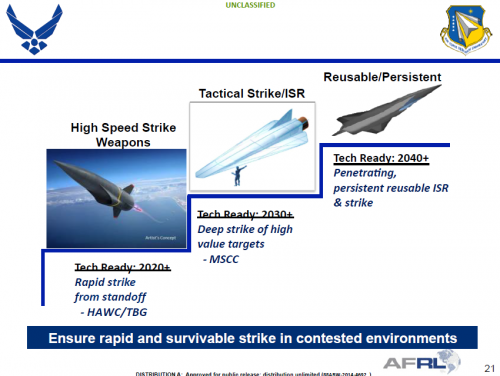
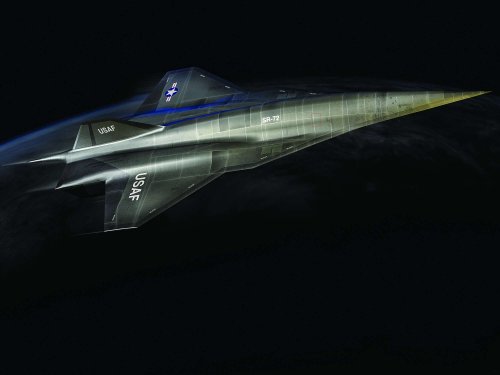
![Other Blackswift 1[1].jpg](/data/attachments/110/110572-6b6d4adf1ad2b056319301050f5aea45.jpg)
![airpower06[1].jpg](/data/attachments/110/110573-2e9ffbb1760b25dda2464e3dc2290dc0.jpg)
